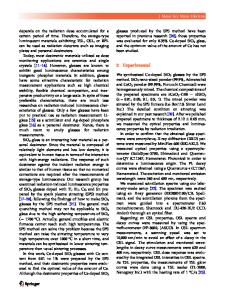Thermoelectric properties of synthesized Mg 2 Si 0.95-x Ge 0.05 Sb x by spark plasma sintering
- PDF / 965,344 Bytes
- 6 Pages / 612 x 792 pts (letter) Page_size
- 10 Downloads / 353 Views
Thermoelectric properties of synthesized Mg2Si0.95-xGe0.05Sbx by spark plasma sintering Asumi Sasaki1, Koya Arai1, Yuto Kimori1, Tomoyuki Nakamura1,2, Kenjiro Fujimoto3, Yuki Yamaguchi3, Ryuji Tamura1, Tsutomu Iida1 and Keishi Nishio1. 1
Department of Materials Science and Technology, Tokyo University of Science, 6-3-1 Niijyuku,
Katsushika-ku, Tokyo 125-8585, Japan 2
SWCC Showa Cable Systems Co., Ltd., LTD, 4-1-1 Minami-Hashimoto Chuo-Ku Sagamihara, Kanagawa,
Japan 3
Department of Pure and Applied Chemistry, Tokyo University of Science, 2641 Yamazaki, Noda-shi,
Chiba 278-8510, Japan Abstract Magnesium silicide (Mg2Si) has attracted much interest as an n-type thermoelectric material because it is eco-friendly, non-toxic, light, and relatively abundant compared with other thermoelectric materials. In this study, we tried to improve the thermoelectric performance by doping Sb and Ge in the Mg2Si, as well as further optimizing x in the carrier concentration to cause phonon scattering. A high purity Mg2Si was synthesized from metal Mg and Sb doped Si-Ge alloy by using spark plasma sintering (SPS) equipment. The sintered samples were cut and polished. They were evaluated by using X-ray diffraction (XRD) and X-ray fluorescence (XRF) analyses. The carrier concentration of the samples was measured by using Hall measurement equipment. The electrical conductivity and Seebeck coefficient were measured by using a standard four-probe method in a He atmosphere. The thermal conductivity was measured by using a laser-flash system. We succeeded in obtaining a Sb doped Mg2Si0.95Ge0.05 sintered body easily without any impurities with the SPS equipment. The electrical conductivity of the sample was increased, and thermal conductivity was decreased by increasing the amount of doped Sb. The dimensionless figure of merit ZT became 0.74 at 733 K in the Mg2Si0.95-xGe0.05Sbx sample with x = 0.0022. Introduction A thermoelectric power generator is a solid-state device that relies on a temperature differential to produce electricity. For a given temperature differential, the thermal to electrical conversion efficiency of a thermoelectric material depends on the dimensionless figure of merit ZT = S2 σT/κ, where S is the Seebeck coefficient, σ is the electrical conductivity, T is the temperature in Kelvin, and κ is the total thermal conductivity, which includes both lattice, κph, and electronic, κel, contributions. An ideal thermoelectric material would possess a large S, high σ, and low κ [1-7]. Recently, Mg2X (X = Si, Ge, Sn) has attracted much interest as an n-type thermoelectric material because it is eco-friendly, non-toxic, light, and relatively abundant compared with other thermoelectric materials [8]. Mg2Si has low performance compared with materials that have been put into practical use because of the large thermal conductivity by phonon. Garg et al. [9] reported that the thermal conductivity of Ge-doped Si decreases enough at 5at%. Therefore, in this study, we selected Sb as the doping element to cause phonon scattering and genera
Data Loading...











